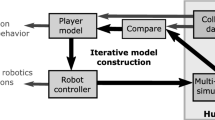
Overview
- Includes supplementary material: sn.pub/extras
Part of the book series: Computational Music Science (CMS)
Access this book
Tax calculation will be finalised at checkout
Other ways to access
About this book
The scientific approach of this book transcends the limits of art literature in that it also develops geometric theories of gestures and distributed identities, also known as swarm intelligence.
We exemplify this approach in the framework of free jazz, which is a prototypical creative and collaborative art form. Leader artists such as John Coltrane, Pharoah Sanders, Cecil Taylor, Sun Ra, The Art Ensemble of Chicago, Albert Ayler, Don Cherry, and Archie Shepp are presented in their strongest works and theories.
The pillars of our theory of collaboration are built from psychologist Mihaly Csikszentmihalyi’s flow, physicist Gilles Châtelet’s gestures, and computer scientist Bill Wulf's collaboratories.
Similar content being viewed by others
Keywords
Table of contents (14 chapters)
-
Front Matter
-
Getting off Ground
-
Front Matter
-
-
The Landscape of Free Jazz
-
Front Matter
-
-
Collaborative Spaces in Free Jazz
-
Front Matter
-
-
Gestural Creativity
-
Front Matter
-
-
What Group Flow Generates
-
Front Matter
-
-
Epilogue
-
Front Matter
-
Reviews
"Managing innovation and spurring team creativity while working under constraints are key ingredients for success in today’s industries. Surprisingly enough, there is an artistic domain in which such concerns are also paramount--jazz improvisation. While understanding how such multifarious collaborations can be encouraged and even nurtured is still a work in progress, this book offers some suggestions on how such endeavors can be approached and theorized, at least in the world of 20th century free jazz music.[...] In summary, the suggested line of thought about the science of collaboration is obviously still undergoing work, and some issues are somewhat abstruse. Anyone interested in the emergence of collaboration, be it in musical, artistic, or innovative processes, will get something out of this book." P. Jouvelot, ACM Computing Reviews, May 2009
"[This book] is at once a contribution to mathematical music theory, the first volume in a Springer-Verlag series on computational music science, and a manifesto on contemporary free jazz as a cultural achievement. ... As a manifesto on the music of a most gifted mathematician, or the mathematically inflected thought of a gifted musician, Mazzola’s book exhibits the kind of energy, vision and passion that he brings to his vocation, and we are richer for it." Charles Turner (2011): Book Review, Jazz Perspectives, 5:1, 105-109
Authors and Affiliations
Bibliographic Information
Book Title: Flow, Gesture, and Spaces in Free Jazz
Book Subtitle: Towards a Theory of Collaboration
Authors: Guerino B. Mazzola, Paul B. Cherlin
Series Title: Computational Music Science
DOI: https://doi.org/10.1007/978-3-540-92195-0
Publisher: Springer Berlin, Heidelberg
eBook Packages: Computer Science, Computer Science (R0)
Copyright Information: Springer-Verlag Berlin Heidelberg 2009
Hardcover ISBN: 978-3-540-92194-3Published: 12 January 2009
Softcover ISBN: 978-3-642-43284-2Published: 14 November 2014
eBook ISBN: 978-3-540-92195-0Published: 21 December 2008
Series ISSN: 1868-0305
Series E-ISSN: 1868-0313
Edition Number: 1
Number of Pages: XIII, 141
Topics: Music, Computer Appl. in Arts and Humanities, Artificial Intelligence, Category Theory, Homological Algebra, Computational Science and Engineering, Media Design



